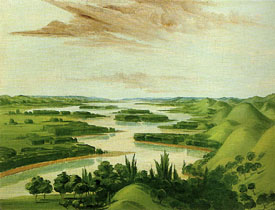
| George Catlin Paintings
Lower Missouri River
James S. Aber |
George Catlin (1796-1872) was a man of many talents and multiple careers. He is best known today as a painter of the American wilderness and particularly of native American peoples of the Great Plains region. During a remarkable burst of activity, between 1832 and 1836, he participated in four expeditions into the northern Mississippi and Missouri regions painting and collecting Indian artifacts. The landscapes and peoples were little changed in the three decades since Lewis and Clark's voyage of discovery.
Catlin painted numerous portraits of individual native Americans as well as scenes of their everyday life in villages, hunting, fishing, and so on. He also documented religious ceremonies and holy places, including the sacred pipestone quarry. Catlin's landscape scenes often were depicted from an aerial point of view, as he envisioned:
- I was lifted up upon an imaginary pair of wings, which ... held me floating in the open air, from whence I could behold beneath me the Pacific and the Atlantic Oceans--the great cities of the East, and the mighty rivers." (Dippie et al. 2002, p. 153).
Caltin's realistic bird's-eye views were forerunners of aerial photography, especially the low-height oblique views of kite aerial photography presented in other sections of this atlas. Although often involved in controversy concerning the accuracy of his paintings, there is no doubt that Catlin's pictures played a major role in the perception of the American West and native American peoples of the Plains. In fact he is considered the Audubon of the Indians (Dippie et al. 2002). The following examples are typical of Catlin's style. Click on small images to see larger pictures.
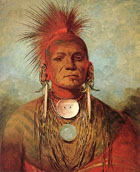
| See-Non-Ty-A, an Iowa medicine man. Impressive portraits of native Americans in full regalia fostered the "noble-savage" notion in the eastern United States and Europe. George Catlin, 1844-45, oil. |
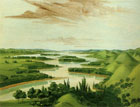
| View from above Floyd's grave, near modern Sioux City, Iowa. The panoramic, aerial perspective of the Missouri River valley imparts a dreamlike quality to the wilderness scene. George Catlin, 1832, oil. |
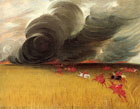
| Prairie meadow burning. Wildfires were among the most dangerous and benefical events in prairie life. The growth of lush green grass followed and attracted the essential buffalo herds. George Catlin, 1832, oil. |
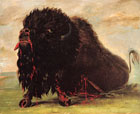
| Dying buffalo, shot with arrow. Dramatic end of an individual bison foreshadowed events to come for both the immense buffalo herds and native Americans of the Great Plains. George Catlin, 1832-33, oil. |
Return to Lewis and Clark atlas.
Last update: April 2004.
